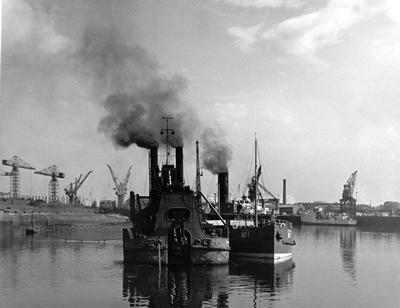
A dredger and hopper barge working on the River Clyde, 1955.
The shallow depths of the Clyde restricted shipping on the river during the early 19th century. In 1824 a new steam dredger started work, scooping up sand, clay and silt from the river bed to deepen and maintain the shipping channel. At first, barges (known as punts) were used to carry the spoil to the riverbanks, where it was spread along the riverbanks. The first self-propelled hopper barges were ordered in 1862, to carry the spoil out to sea for dumping.
In time, the dredgers increased the depth of the Clyde's navigation channel from 11 feet to almost 40 feet, enabling the development of Glasgow as a port and a centre of shipbuilding.
In 1955 the Clyde Navigation Trust operated four dredgers: Craigiehall (built in 1903); Shieldhall (1906); Rosslyn (1912) and the brand new Cessnock, delivered to the Trust in June 1955.
In 1955 Partick Camera Club set out to create a photographic survey of Glasgow. As the project progressed, other camera clubs joined and each was allocated a district of the city to photograph. Glasgow Museums exhibited the photographs at Kelvingrove Art Gallery and Museum and at the People's Place, and in 1956 the exhibition was shown at the Palace of Art in Bellahouston Park. The photographs are now part of Glasgow Museums' collections.
Reference: 1005.97.323 / OG.1955.121.[258]
Reproduced with the permission of the Partick Camera Club
Keywords:
Cessnock, Clyde Navigation Trust, Craigiehall, cranes, dredgers, dredging, Glasgow Photographic Survey 1955, hopper barges, hoppers, River Clyde, Rosslyn, Shieldhall
You have 0 images in your photo album.